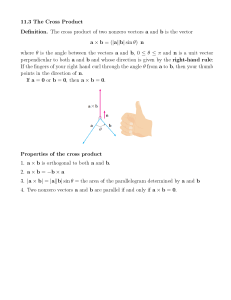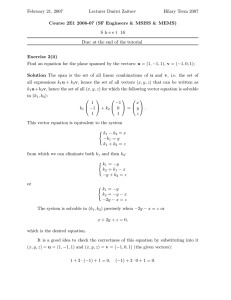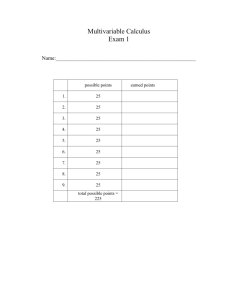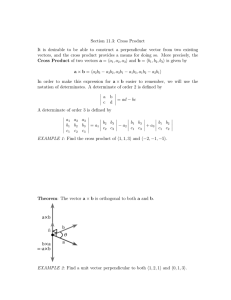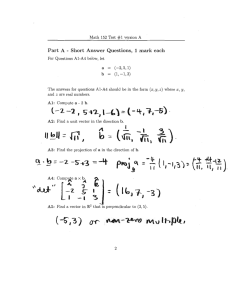Math 152 Class Notes December 3, 2015 11.3 The Cross Product
advertisement
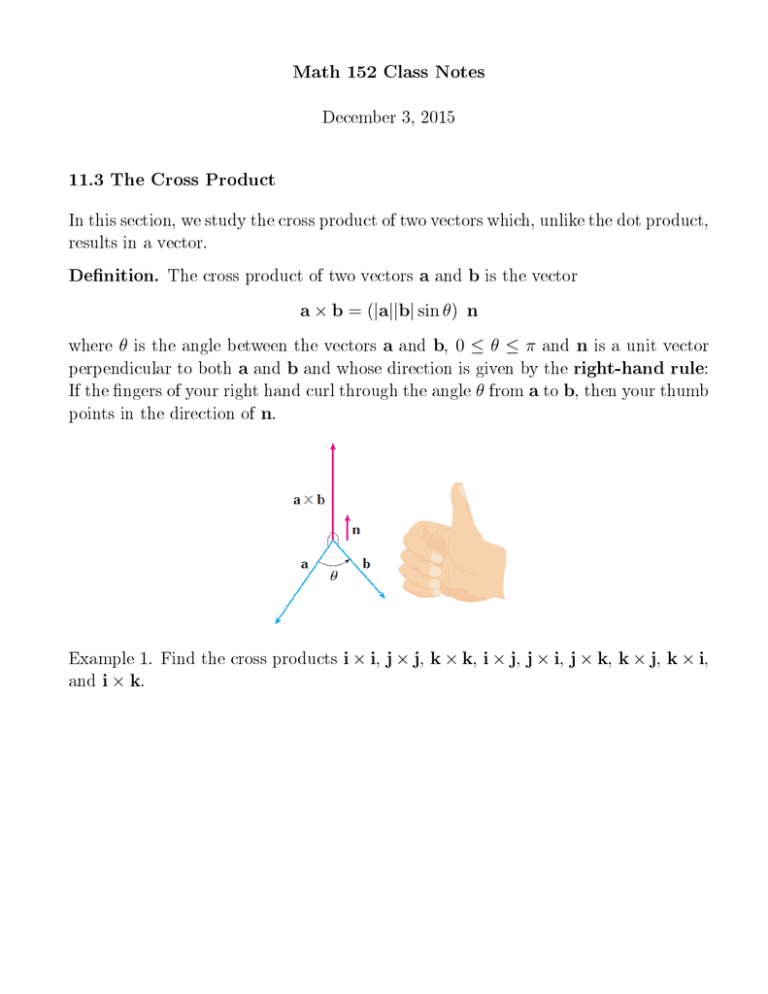
Math 152 Class Notes December 3, 2015 11.3 The Cross Product In this section, we study the cross product of two vectors which, unlike the dot product, results in a vector. Denition. The cross product of two vectors a and b is the vector a × b = (|a||b| sin θ) n where θ is the angle between the vectors a and b, 0 ≤ θ ≤ π and n is a unit vector perpendicular to both a and b and whose direction is given by the right-hand rule: If the ngers of your right hand curl through the angle θ from a to b, then your thumb points in the direction of n. Example 1. Find the cross products i × i, j × j, k × k, i × j, j × i, j × k, k × j, k × i, and i × k. Properties of the cross product 1. a × b is orthogonal to both a and b. 2. |a × b| = |a||b| sin θ 3. Two nonzero vectors a and b are parallel if and only if a × b = 0. 4. a × b = −b × a 5. (ka) × b = k(a × b) = a × (kb) 6. c × (a + b) = c × a + c × b 7. (a + b) × c = a × c + b × c By Properties 6 and 7 (the Vector Distributive Laws), we can compute the cross product of two vectors a = a1 i + a2 j + a3 k and b = b1 i + b2 j + b3 k in terms of their components. a × b = (a2 b3 − a3 b2 )i + (a3 b1 − a1 b3 )j + (a1 b2 − a2 b1 )k The cross product can be dened using determinant. A determinant of order 2 is dened by a b c d = ad − bc A determinant of order 3 is dened by a1 a2 a3 b2 b3 b1 b3 b1 b2 b1 b2 b3 =a1 c2 c3 − a2 c1 c3 + a3 c1 c2 c1 c2 c3 =a1 (b2 c3 − b3 c2 ) − a2 (b1 c3 − b3 c1 ) + a3 (b1 c2 − b2 c1 ) The cross product of a = a1 i + a2 j + a3 k and b = b1 i + b2 j + b3 k is i j k a2 a3 a1 a3 a1 a2 i − a × b = a1 a2 a3 = b1 b3 j + b1 b2 k b b 2 3 b1 b2 b3 =(a2 b3 − a3 b2 )i − (a1 b3 − a3 b1 )j + (a1 b2 − a2 b1 )k Example 1. Find the cross product of a = h1, 2, −1i and b = h3, −1, 7i Example 2. Find a vector perpendicular to the plane that passes through the points A(2, 3, −2), B(1, −1, 0) and C(2, 0, 3) In geometry, we have the following interpretation of the magnitude of a cross product. The length of the cross product a × b is equal to the area of the parallelogram determined by a and b. Example 3. Given the points A(5, 5, 1), B(3, 3, 2) and C(1, 4, 4), nd the area of 4ABC . For three vectors a, b and c, we dene their scalar triple product as a · (b × c) The geometric signicance of the scalar triple product can be seen by considering the parallelepiped determined by the vectors a, b and c. The volume of the parallelepiped determined by the vectors a, b and c is the magnitude of their scalar triple product: V = |a · (b × c)| Example 4. The volume of the parallelepiped whose corner is formed by the vectors a = h2, −1, 4i, b = h1, −3, 0i and c = h3, 1, −2i. Example 5. Given the points A(1, 0, 1), B(2, 3, 0), C(−1, 1, 4) and D(0, 3, 2), nd the −→ −→ −−→ volume of the parallelepiped with adjacent edges AB , AC and AD.

